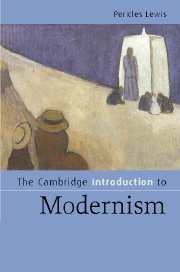Book contents
- Frontmatter
- Contents
- List of illustrations
- List of tables
- Abbreviations and editions used
- Acknowledgments
- Preface
- Introduction
- Part I Origins
- Chapter 1 Trials of modernity
- Chapter 2 Primitivists and modernizers
- Chapter 3 The avant-garde and high modernism
- Part II Genres
- Part III Fate
- Conclusion: after modernism?
- Chronology
- Notes
- Index
Chapter 3 - The avant-garde and high modernism
Published online by Cambridge University Press: 05 February 2015
- Frontmatter
- Contents
- List of illustrations
- List of tables
- Abbreviations and editions used
- Acknowledgments
- Preface
- Introduction
- Part I Origins
- Chapter 1 Trials of modernity
- Chapter 2 Primitivists and modernizers
- Chapter 3 The avant-garde and high modernism
- Part II Genres
- Part III Fate
- Conclusion: after modernism?
- Chronology
- Notes
- Index
Summary
When Gertrude Stein decided to write the story of her life, she did so in the voice of her lover, Alice B. Toklas. In The Autobiography of Alice B. Toklas (1933), Stein has Toklas describe her first dinner, in 1907, at Stein's home at 27, rue de Fleurus, Paris, where the walls were covered with paintings by Paul Cézanne, Paul Gauguin, Henri Matisse, Pablo Picasso, and Pierre Auguste Renoir, then mostly unknown to Americans from San Francisco like Toklas. Seated next to Picasso, who was flustered at having arrived late, Toklas tried to calm him down by murmuring that she liked his painting of Stein. The portrait, influenced by Picasso's fascination with Iberian masks, marked an important stage in his development of cubism. Stein records Picasso's response to Toklas: “Yes, he said, everybody says that she does not look like it but that does not make any difference, she will, he said.” In her memoir of Picasso, Stein wrote, “I was and still am satisfied with my portrait, for me it is I, and it is the only reproduction of me which is always I, for me.” Stein's story about Picasso's portrait of her encapsulates the mythology of the avant-garde, the French term for a vanguard (the leading troops in a battle), which referred by extension to the most radical innovators in the arts.
- Type
- Chapter
- Information
- The Cambridge Introduction to Modernism , pp. 95 - 126Publisher: Cambridge University PressPrint publication year: 2007

